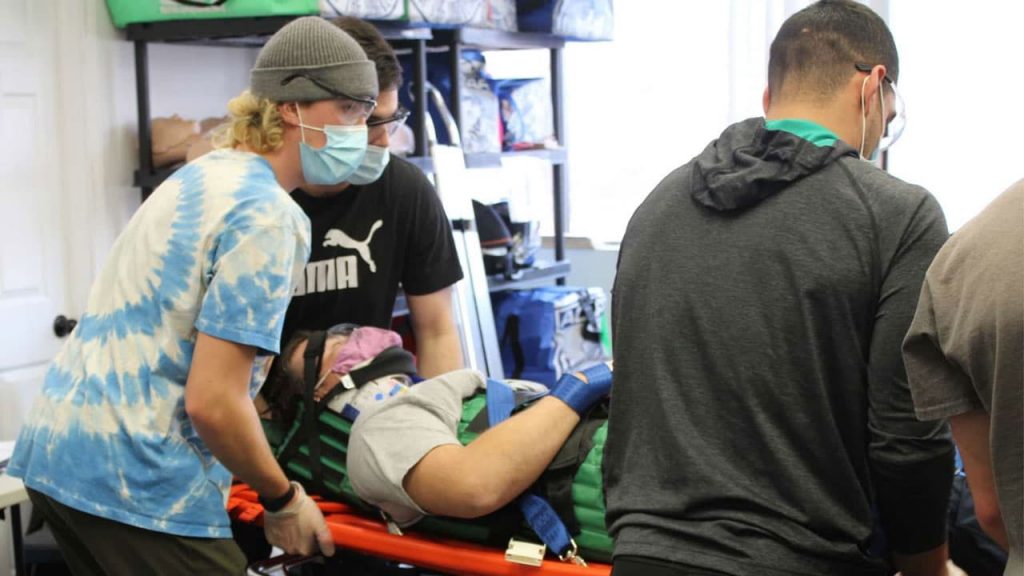Communities rely heavily on their emergency medical responders which means we must understand the process of emergency medical responder training. The best training assures they are equipped with the skills, knowledge, and practical experience to treat any emergency, whether it involves injuries or an illness.
Emergency Medical Responder (EMR) training prepares its participants to provide entry-level medical and trauma care within industrial settings and for community health care services. This is the highest level of First Aid and CPR/AED training.
Once training is complete, responders can assist in a variety of settings, whether they are the first to arrive on the scene, or working in collaboration with other first responders (police, fire department). Responders can also work with other EMRs or healthcare providers or provide support for community support services. In remote areas, EMRs may be the only medical providers.
Courses vary according to various jurisdictional requirements, but trainees are trained in all the skills required for patient assessments, various medical interventions, and on-going care. They also learn how to transport a patient to a healthcare facility. This training follows the national Occupational Competency Profiles (NCOP) as defined by the Paramedic Association of Canada.





Candidate requirements and prerequisites
The process of emergency medical responder training has prerequisites which must be met. EMR courses are meant for emergency care professionals, and they are trained to offer initial patient assessments and provide safe and careful care. They also ensure the safe transportation of victims to the nearest healthcare facility. Applicants for EMR courses must have a valid Standard First Aid Certification and CPR level C training certificate. On the other hand, if you are looking for Private/Group training for Healthcare professionals, Coast2Coast offers the best-tailored courses to accommodate all your needs.Course completion
Course duration is between 80 and 120 hours (this depends on the jurisdiction). Completion depends on the candidate’s success in demonstrating the knowledge and required skills in a medical and trauma scenario. Written examinations are closed book. All courses require 100% attendance to ensure completion.
Duration of certification
EMR certification is valid for three years, and thereafter another 40 hours of training ensures recertification for another 3 years.Career potential
Upon successful completion of EMR training, EMRs can be employed in a clinic, as first responders in ground ambulances, fire services, industrial environments and more.Content of an EMR course
Medical and rescue technology continues to change. EMR training requires that responders are taught their skills on the latest equipment and are shown the newest life-saving techniques. Courses combine theory and practical training. The process of emergency medical responder training includes:- The Professional Responder – This teaches the responder how to sustain life, reduce pain, and ensure the consequences of illness or injuries are minimized. On receiving certification, the responder can function as a member of a health care team in any pre-hospital setting
- Responding to a call and scene management
- Infection and disease prevention and control to keep everyone, including themselves safe
- Anatomy and physiology training
- Assessment of the injuries or illness
- Management of the airway and respiratory emergencies
- Treating circulatory emergencies
- Treating all types of shock
- Stopping hemorrhage and handling of soft tissue trauma
- Management of musculoskeletal injuries
- Recognizing and managing chest, abdominal and pelvic injuries
- Management of head and spinal injuries
- Recognizing and managing acute and chronic illnesses
- Poisoning management
- Environmental illnesses and their management
- Responding to pregnancy, labor, and delivery emergencies
- Understanding of special populations
- Crisis intervention management
- Procedures for reaching, lifting, and extricating patients
- Transportation procedures
- Coping with multiple-casualty incidents
- Pharmacology, including dosages and side effects
- Handling crises in a marine environment
- Workplace emergencies and regulations

EMR challenges and rewards
EMR presents the opportunity for a rewarding career because it is so important to society. Offering care where it’s needed most and saving lives regularly makes a positive difference to EMRs. Training ensures proper safety precautions are taught which makes meeting the challenges of the job easier. Challenges include infection from patients who may have a contagious disease, lifting heavy weights, and sometimes the restraint of patients with emotional issues. When duty calls, the hours are sometimes long. EMRs work nights and weekends, but the job also provides for longer days off. As health care professionals, responders can be affected by the stress of the job. However, even though taking care of others may entail seeing severe injuries, death, and mental illness, the rewards of saving lives compensate for this. One of the greatest rewards is the respect shown by communities to EMRs. Responders also meet patients from all walks of life and work closely with all other people offering community services in their area. If you have the need to take care of others and want to offer an important service to your community, then enroll for EMR training.
Enroll in EMR training today
If you are interested in becoming a professional responder for your community, check out Coast2Coast’s EMR training courses. Training courses are currently offered throughout the GTA and London. To find out more, check out our website or contact our office toll-free at 866-291-9121.Become an Emergency Responder!
Join our Emergency Medical Responder (EMR) training and equip yourself with the critical skills needed to respond to emergencies effectively. Learn from experienced instructors and gain hands-on experience that can make a real difference.




















No comment yet, add your voice below!